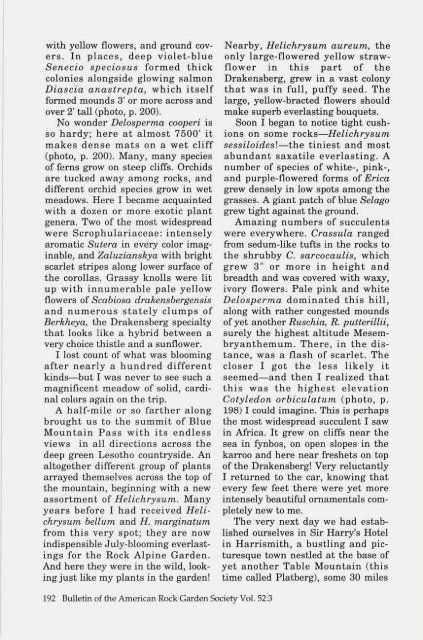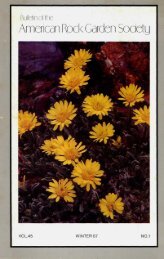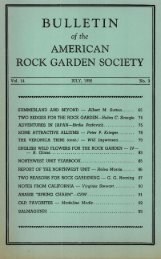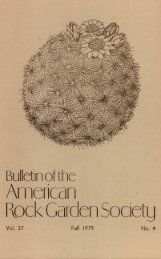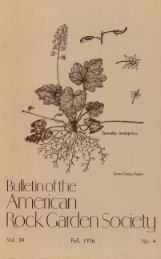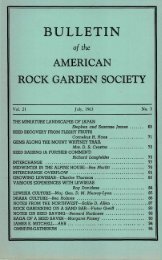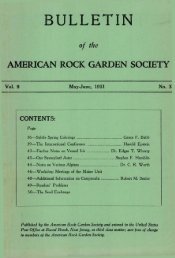Bulletin - Summer 1994 - North American Rock Garden Society
Bulletin - Summer 1994 - North American Rock Garden Society
Bulletin - Summer 1994 - North American Rock Garden Society
Create successful ePaper yourself
Turn your PDF publications into a flip-book with our unique Google optimized e-Paper software.
with yellow flowers, and ground covers.In places, deep violet-blueSenecio speciosus formed thickcolonies alongside glowing salmonDiascia anastrepta, which itselfformed mounds 3' or more across andover 2' tall (photo, p. 200).No wonder Delosperma cooperi isso hardy; here at almost 7500' itmakes dense mats on a wet cliff(photo, p. 200). Many, many speciesof ferns grow on steep cliffs. Orchidsare tucked away among rocks, anddifferent orchid species grow in wetmeadows. Here I became acquaintedwith a dozen or more exotic plantgenera. Two of the most widespreadwere Scrophulariaceae: intenselyaromatic Sutera in every color imaginable,and Zaluzianskya with brightscarlet stripes along lower surface ofthe corollas. Grassy knolls were litup with innumerable pale yellowflowers of Scabiosa drakensbergensisand numerous stately clumps ofBerkheya, the Drakensberg specialtythat looks like a hybrid between avery choice thistle and a sunflower.I lost count of what was bloomingafter nearly a hundred differentkinds—but I was never to see such amagnificent meadow of solid, cardinalcolors again on the trip.A half-mile or so farther alongbrought us to the summit of BlueMountain Pass with its endlessviews in all directions across thedeep green Lesotho countryside. Analtogether different group of plantsarrayed themselves across the top ofthe mountain, beginning with a newassortment of Helichrysum. Manyyears before I had received Helichrysumbellum and H. marginatumfrom this very spot; they are nowindispensible July-blooming everlastingsfor the <strong>Rock</strong> Alpine <strong>Garden</strong>.And here they were in the wild, lookingjust like my plants in the garden!Nearby, Helichrysum aureum, theonly large-flowered yellow strawflowerin this part of theDrakensberg, grew in a vast colonythat was in full, puffy seed. Thelarge, yellow-bracted flowers shouldmake superb everlasting bouquets.Soon I began to notice tight cushionson some rocks—Helichrysumsessiloidesl—the tiniest and mostabundant saxatile everlasting. Anumber of species of white-, pink-,and purple-flowered forms of Ericagrew densely in low spots among thegrasses. A giant patch of blue Selagogrew tight against the ground.Amazing numbers of succulentswere everywhere. Crassula rangedfrom sedum-like tufts in the rocks tothe shrubby C. sarcocaulis, whichgrew 3" or more in height andbreadth and was covered with waxy,ivory flowers. Pale pink and whiteDelosperma dominated this hill,along with rather congested moundsof yet another Ruschia, R. putterillii,surely the highest altitude Mesembryanthemum.There, in the distance,was a flash of scarlet. Thecloser I got the less likely itseemed—and then I realized thatthis was the highest elevationCotyledon orbiculatum (photo, p.198) I could imagine. This is perhapsthe most widespread succulent I sawin Africa. It grew on cliffs near thesea in fynbos, on open slopes in thekarroo and here near freshets on topof the Drakensberg! Very reluctantlyI returned to the car, knowing thatevery few feet there were yet moreintensely beautiful ornamentals completelynew to me.The very next day we had establishedourselves in Sir Harry's Hotelin Harrismith, a bustling and picturesquetown nestled at the base ofyet another Table Mountain (thistime called Platberg), some 30 miles192 <strong>Bulletin</strong> of the <strong>American</strong> <strong>Rock</strong> <strong>Garden</strong> <strong>Society</strong> Vol. 52:3


